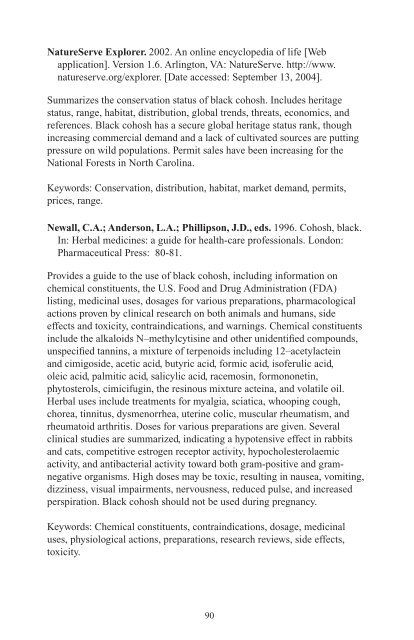Black Cohosh - Non-Timber Forest Products
Black Cohosh - Non-Timber Forest Products
Black Cohosh - Non-Timber Forest Products
Create successful ePaper yourself
Turn your PDF publications into a flip-book with our unique Google optimized e-Paper software.
NatureServe Explorer. 2002. An online encyclopedia of life [Web<br />
application]. Version 1.6. Arlington, VA: NatureServe. http://www.<br />
natureserve.org/explorer. [Date accessed: September 13, 2004].<br />
Summarizes the conservation status of black cohosh. Includes heritage<br />
status, range, habitat, distribution, global trends, threats, economics, and<br />
references. <strong>Black</strong> cohosh has a secure global heritage status rank, though<br />
increasing commercial demand and a lack of cultivated sources are putting<br />
pressure on wild populations. Permit sales have been increasing for the<br />
National <strong>Forest</strong>s in North Carolina.<br />
Keywords: Conservation, distribution, habitat, market demand, permits,<br />
prices, range.<br />
Newall, C.A.; Anderson, L.A.; Phillipson, J.D., eds. 1996. <strong>Cohosh</strong>, black.<br />
In: Herbal medicines: a guide for health-care professionals. London:<br />
Pharmaceutical Press: 80-81.<br />
Provides a guide to the use of black cohosh, including information on<br />
chemical constituents, the U.S. Food and Drug Administration (FDA)<br />
listing, medicinal uses, dosages for various preparations, pharmacological<br />
actions proven by clinical research on both animals and humans, side<br />
effects and toxicity, contraindications, and warnings. Chemical constituents<br />
include the alkaloids N–methylcytisine and other unidentified compounds,<br />
unspecified tannins, a mixture of terpenoids including 12–acetylactein<br />
and cimigoside, acetic acid, butyric acid, formic acid, isoferulic acid,<br />
oleic acid, palmitic acid, salicylic acid, racemosin, formononetin,<br />
phytosterols, cimicifugin, the resinous mixture acteina, and volatile oil.<br />
Herbal uses include treatments for myalgia, sciatica, whooping cough,<br />
chorea, tinnitus, dysmenorrhea, uterine colic, muscular rheumatism, and<br />
rheumatoid arthritis. Doses for various preparations are given. Several<br />
clinical studies are summarized, indicating a hypotensive effect in rabbits<br />
and cats, competitive estrogen receptor activity, hypocholesterolaemic<br />
activity, and antibacterial activity toward both gram-positive and gramnegative<br />
organisms. High doses may be toxic, resulting in nausea, vomiting,<br />
dizziness, visual impairments, nervousness, reduced pulse, and increased<br />
perspiration. <strong>Black</strong> cohosh should not be used during pregnancy.<br />
Keywords: Chemical constituents, contraindications, dosage, medicinal<br />
uses, physiological actions, preparations, research reviews, side effects,<br />
toxicity.<br />
90


